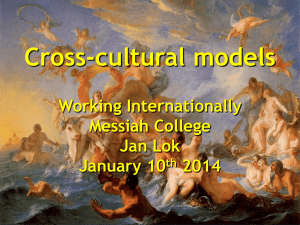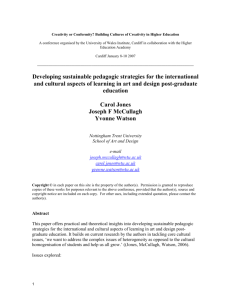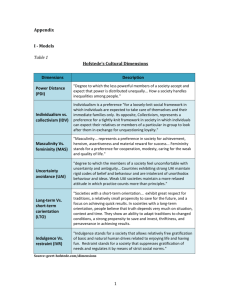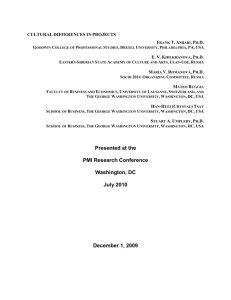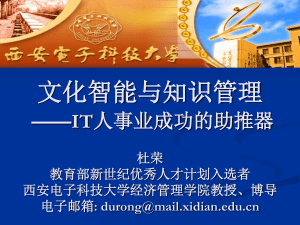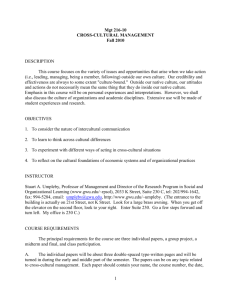95 THE TROMPENAARS' SEVEN-DIMENSION CULTURAL MODEL
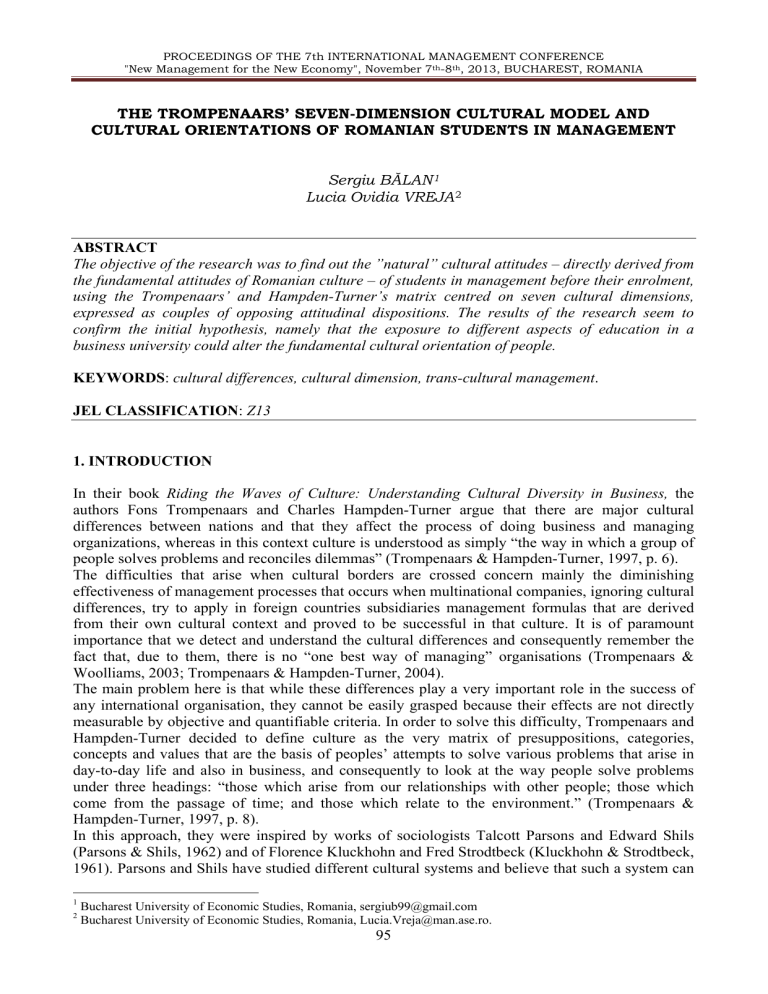
PROCEEDINGS OF THE 7th INTERNATIONAL MANAGEMENT CONFERENCE
"New Management for the New Economy", November 7 th -8 th , 2013, BUCHAREST, ROMANIA
THE TROMPENAARS’ SEVEN-DIMENSION CULTURAL MODEL AND
CULTURAL ORIENTATIONS OF ROMANIAN STUDENTS IN MANAGEMENT
Sergiu B Ă LAN
Lucia Ovidia VREJA
ABSTRACT
The objective of the research was to find out the ”natural” cultural attitudes – directly derived from the fundamental attitudes of Romanian culture – of students in management before their enrolment, using the Trompenaars’ and Hampden-Turner’s matrix centred on seven cultural dimensions, expressed as couples of opposing attitudinal dispositions. The results of the research seem to confirm the initial hypothesis, namely that the exposure to different aspects of education in a business university could alter the fundamental cultural orientation of people.
KEYWORDS : cultural differences, cultural dimension, trans-cultural management .
JEL CLASSIFICATION : Z13
1. INTRODUCTION
In their book Riding the Waves of Culture: Understanding Cultural Diversity in Business, the authors Fons Trompenaars and Charles Hampden-Turner argue that there are major cultural differences between nations and that they affect the process of doing business and managing organizations, whereas in this context culture is understood as simply “the way in which a group of people solves problems and reconciles dilemmas” (Trompenaars & Hampden-Turner, 1997, p. 6).
The difficulties that arise when cultural borders are crossed concern mainly the diminishing effectiveness of management processes that occurs when multinational companies, ignoring cultural differences, try to apply in foreign countries subsidiaries management formulas that are derived from their own cultural context and proved to be successful in that culture. It is of paramount importance that we detect and understand the cultural differences and consequently remember the fact that, due to them, there is no “one best way of managing” organisations (Trompenaars &
Woolliams, 2003; Trompenaars & Hampden-Turner, 2004).
The main problem here is that while these differences play a very important role in the success of any international organisation, they cannot be easily grasped because their effects are not directly measurable by objective and quantifiable criteria. In order to solve this difficulty, Trompenaars and
Hampden-Turner decided to define culture as the very matrix of presuppositions, categories, concepts and values that are the basis of peoples’ attempts to solve various problems that arise in day-to-day life and also in business, and consequently to look at the way people solve problems under three headings: “those which arise from our relationships with other people; those which come from the passage of time; and those which relate to the environment.” (Trompenaars &
Hampden-Turner, 1997, p. 8).
In this approach, they were inspired by works of sociologists Talcott Parsons and Edward Shils
(Parsons & Shils, 1962) and of Florence Kluckhohn and Fred Strodtbeck (Kluckhohn & Strodtbeck,
1961). Parsons and Shils have studied different cultural systems and believe that such a system can
1
Bucharest University of Economic Studies, Romania, sergiub99@gmail.com
2
Bucharest University of Economic Studies, Romania, Lucia.Vreja@man.ase.ro.
95
PROCEEDINGS OF THE 7th INTERNATIONAL MANAGEMENT CONFERENCE
"New Management for the New Economy", November 7 th -8 th , 2013, BUCHAREST, ROMANIA be understood as a network of values, norms and symbols which determine the choices made by people in their decisions and actions and prescribe the modes of interaction which may occur among people. In each culture, the norms and values that determine peoples’ choices are structured by a pattern of five couples of opposing cultural dimensions: (1) affectivity – affective neutrality;
(2) self-orientation – collectivity-orientation; (3) universalism – particularism; (4) ascription – achievement; and (5) specificity – diffuseness. (Parsons & Shils, 1962, pp. 80-85). Kluckhohn and
Strodtbeck in turn have discovered that in different cultures, people are accustomed to have specific hierarchies of values, each called a “continuum”, according to the perceived importance of each value in one culture or another. Cultures differ according to their specific “value orientations”, i.e. conceptions about what is considered to be desirable or appropriate, and according to Kluckhohn and Strodtbeck, there are five possible criteria of describing a value orientation: (1) human nature orientation; (2) man-nature orientation; (3) time orientation; (4) activity orientation; and (5) relational orientation (Kluckhohn & Strodtbeck, 1961, pp. 11 ff).
In their turn, Trompenaars and Hampden-Turner have identified seven cultural dimensions, expressed as couples of opposing attitudinal dispositions that can be identified in each culture. The main five concern the first of their three criteria (relationships with other people): (1) universalism versus particularism; (2) individualism versus communitarianism; (3) neutral versus emotional; (4) specific versus diffuse; (5) achievement versus ascription. The next one, (6) sequential time versus synchronous time, arises from the specific conceptions about the passage of time, and the last one,
(7) internal direction versus outer direction, concerns the understanding of the specific relation of people with their natural environment (Trompenaars & Hampden-Turner, 1997, pp. 8-10). We will explain each in brief later on in this paper.
Of course, this model of cultural dimensions structure is by no means the only one formulated by the scholars in the field of trans-cultural management. For instance, another very well-known theory is the one proposed by Geert Hofstede, after a detailed study mapping over 50 countries and originally designed to evaluate work values, so we can expect it to be based on a slightly different set of cultural dimensions: (1) power distance (the degree of equality, or inequality between people in society); (2) individualism vs. collectivism (the degree to which people of a society understand themselves as individuals, as apart from their group); (3) masculinity vs. femininity (the degree the society reinforces or not the traditional masculine work role model); (4) uncertainty avoidance (the degree to which people in a society feel uncomfortable in unexpected, surprising and unknown situations) and (5) long-term vs. short-term orientation (the degree people attach importance to a future oriented way of thinking rather than to a short-term oriented one) (Hofstede, 1980; 2001).
Another important theory belongs to Shalom H. Schwartz (Schwartz, 1992, 1999), who concentrates his attention on cultural values, seen as the basis for “the ways that societal institutions
(e.g., the family, education, economic, political, and religious systems) function, their goals and their modes of operation” (Schwartz, 1999, p. 25). He derived seven types of values, structured along three bi-polar dimensions that represent alternative ways of solving different problems encountered in everyday life and in business relations: (1) conservatism versus autonomy
(concerning the relationship between the individual and the group); (2) hierarchy versus egalitarianism (concerning the behaviour that will best preserve the social structures); (3) mastery versus harmony (concerning peoples’ relations to natural and social environment) (Schwartz, 1999, pp. 26 ff).
Yet another model was formulated by the late Professor Robert J. House, who initiated Project
GLOBE (Global Leadership and Organizational Behavior Effectiveness), an extensive quantitative and qualitative cross-cultural study which was based on responses of 17,370 managers from 951 organizations in 62 societies to 735 questionnaire items ( http://business.nmsu.edu/programscenters/globe/ ). Understanding culture as the “shared motives, values, beliefs, identities, and interpretations or meanings of significant events that result from common experiences of members of collectives that are transmitted across generation” (House et al ., 2004, p. 15), House and his colleagues identified nine cultural dimensions that they believe can be pragmatically applied in
96
PROCEEDINGS OF THE 7th INTERNATIONAL MANAGEMENT CONFERENCE
"New Management for the New Economy", November 7 th -8 th , 2013, BUCHAREST, ROMANIA trans-cultural management science. These are: (1) power distance (the degree of peoples’ expectance that power is to be distributed equally), (2) uncertainty avoidance (the degree of peoples’ expectance that social norms, rules, and procedures will diminish the unpredictability of future events), (3) assertiveness (the degree people are assertive, confrontational, and aggressive in their relationships with others), (4) institutional collectivism (the degree social institution promote collective distribution of resources and collective action), (5) in-group collectivism (the degree of peoples’ loyalty towards organizations, groups, families), (6) future orientation (the degree people engage in future-oriented behaviours such as planning and investing), (7) performance orientation
(the degree people encourage and reward performance of others), (8) humane orientation (the degree people encourage and reward others for being altruistic, fair and generous), and (9) gender egalitarianism (the degree a society minimises gender inequality) (House et al ., 2004, p. 30).
What distinguishes Trompenaars’ approach is the fact that it is founded on his very extensive experience in the practice of international consulting for trans-cultural business management. Since
1989, when he founded the Centre for International Business Studies, a consulting and training organization for international management (which in 1998, when Charles Hampden-Turner became partner, was called “Trompenaars Hampden-Turner”), he worked as a consultant for many important companies, such as Shell, Philips, Heineken, Mars, Motorola, General Motors, Nike and
Merrill Lynch. During those years, ”Trompenaars Hampden-Turner” provided consulting services for international organizations in over 100 countries and gathered a data-base of more than 100,000 entries, consisting mainly in answers to tests conceived as problems and dilemmas (cca 6,000) concerning competing values from both national and organizational cultural differences. They have applied these tests on managers from more than 500 organizations and have built their sevendimension model on the basis of their answers ( http://www2.thtconsulting.com
)
This is where things become even more interesting from our point of view, because Romania is one of the countries surveyed by Trompenaars, and the results he got from inviting Romanian managers answer to the dilemmas in his tests seem rather intriguing.
According to the three criteria of his seven-dimension model, for which he offers the tests’ results,
Trompenaars believes that Romanian management culture presents the following features:
(1) From the point of view of dichotomy between universalist versus particularist orientations,
Romanians are rather universalists, scoring 88 points from 100, and being ranked on 9th place of 31 countries surveyed (the first being Switzerland, with 97 points, and the last one Venezuela, with only 32 points). In another test concerning the same cultural feature, they proved to be even higher ranked, on 5th place, scoring 68 from 100, but in a third one, they scored only 44 form 100 points, being accordingly placed on the 23rd position from 31 countries. On average, however, they scored a 66.66 percentage, which firmly describes them as less particularists and more universalists
(Trompenaars & Hampden-Turner, 1997, pp. 35, 37, 39).
(2) From the point of view of dichotomy between individualist versus communitarian orientations,
Romanians are found to be surprisingly individualist, scoring 81 points from 100 in a test designed to quantify the option for individualist/communitarian attitudes when it comes to find the best way to improve life quality, and being ranked second from 40 countries surveyed (the first being Israel, with 88 points, and the last one Egypt, with only 30 points). In another test, designed to correlate individualist/communitarian options with the problem of the best way of organizing work and rewarding workers, Romanians scored only 52 points of 100, being ranked 28 from 40 countries. In a third test, designed to correlate individualist/communitarian options with the problem of responsibility in the workplace, they scored again a very high relative percentage, of 64 from 100
(the highest being Cuba, with 69), and ranking 4th from 40 nations (Trompenaars & Hampden-
Turner, 1997, pp. 51, 55, 57).
(3) From the point of view of dichotomy between internal direction versus outer direction,
(concerning the specific relation of people with their natural environment), Romanians ranked first from 48 nations in a test designed to find out the degree of belief that people can and should control nature by imposing their will upon it, scoring 68 points from 100. In a second test, designed with
97
PROCEEDINGS OF THE 7th INTERNATIONAL MANAGEMENT CONFERENCE
"New Management for the New Economy", November 7 th -8 th , 2013, BUCHAREST, ROMANIA the purpose to find out the degree of peoples’ belief that they are the only masters of their own destiny, Romanians scored 70 of 100 points, ranking 25th from 48 nations (Trompenaars &
Hampden-Turner, 1997, pp. 143, 144).
The conclusions that must be derived from these data are that Romanian managers tested by
Trompenaars proved to be rather universalists and inner-directed and strongly individualists. These conclusions rise a fundamental question, which was for us the reason we conceived this study: are those value-orientations that Trompenaars claims to have found by testing Romanian managers a product of the general context of national Romanian culture, or are they only a product of education received by those managers in business schools they attended? In other words, are they a natural product of Romanian culture, or are they an artificial product of the principles that guide business education?
In order to provide an answer to this question, we tried to find out which are the value orientation of young people before they begin their education in management, for we believe that these reflect their “natural” attitudes, namely those derived directly from the fundamental attitudes of Romanian culture. Consequently, we used a set of tests formulated as dilemmas by Trompenaars, who has grouped them in his book under the rubric “test yourself”, to make possible for the reader to asses himself according to the seven-dimension model he proposed. We have applied these tests to 191 students, (aged between 18 and 32, with an average of 20 years old, of which 35.5 males and 64.5 females) who enrolled the Faculty of Management of Bucharest University of Economic Studies in the year 2013, in order to assess their value-orientation before they will be modified by the students’ exposure to the various aspects of the educational programme. We will present the results according to the headings of Trompenaars’s seven-dimension model, explaining briefly each of them and also the test we used to assess it.
2. UNIVERSALISM VERSUS PARTICULARISM (RULES VERSUS RELATIONSHIPS)
According to Trompenaars, in universalistic cultures people generally adhere to the standards which are universally agreed and relations between them are prescribed by laws, rules, general values and obligations. Always rules come before personal relationships. In particularist cultures, on the other hand, personal relationships come always before universal rules and laws, and individuals’ behaviour is determined by the particular obligations to the people they know in person. Typical universalist cultures are Swizerland, U.S.A. and Canada; typical particularist cultures are Russia,
China, India.
In an universalist culture, “(1) Focus is more on rules than relationships; (2) Legal contracts are readily drawn up; (3) A trustworthy person is the one who honours their word or contract; (4) There is only one truth or reality, that which has been agreed to. (5) A deal is a deal.”
In the case of a particularist one, on the other hand, “(1) Focus is more on relationships than on rules; (2) Legal contracts are readily modified; (3) A trustworthy person is the one who honours changing mutualities; (4) There are several perspectives on reality relative to each participant; (5)
Relationships evolve.” (Trompenaars & Hampden-Turner, 1997, pp. 29-48).
The test we used for our students is the following dilemma:
“Six months after the ABC mining company had signed a long-term contract with a foreign buyer to buy bauxite in 10 annual installments, the world price of bauxite collapsed. Instead of paying $4 a tone below world market price, the buyer now faced the prospect of paying $3 above.
The buyer faxed ABC to say it wished to renegotiate the contract. The final words of the fax read:
“You cannot expect us as your new partner to carry alone the now ruinous expense of these contract terms.”
ABC negotiators had a heated discussion about this situation. Several views were offered:
1. A contract is a contract. It means precisely what its terms say. If the world price had risen we would not be crying, nor should they. What partnership are they talking about? We had a deal.
We bargained. We won. End of story.
98
PROCEEDINGS OF THE 7th INTERNATIONAL MANAGEMENT CONFERENCE
"New Management for the New Economy", November 7 th -8 th , 2013, BUCHAREST, ROMANIA
2. A contract symbolizes the underlying relationship. It is an honest statement of original intent.
Where circumstances transform the mutual spirit of that contract, then terms must be renegotiated to preserve the relationship.
3. A contact symbolizes the underlying relationship. It is an honest statement of original intent But such rigid terms are too brittle to withstand turbulent environments. Only tacit forms of mutuality have the flexibility to survive.
4. A contract is a contract. It means precisely what the terms say. If the world price had risen we would not be crying, nor should they. We would, however, consider a second contract whose terms would help offset their losses.”
Answer (1) is a full universalist answer; (2) is a full particularist answer; (3) is a particularist answer doubled by an universal orientation; (4) is a universalist answer but recognizing the importance of particular relationships (Trompenaars & Hampden-Turner, 1997, pp. 47-48).
The results were as follows:
Figure 1.
Universalism versus particularism
3. INDIVIDUALISM VERSUS COMMUNITARIANISM (THE GROUP VERSUS THE
INDIVIDUAL)
In individualist cultures, the person is believed to be more important than the group. People cherish personal freedom and initiative, individual decision and responsibility and reward personal achievement: everyone must make his own decisions and take care of himself. In communitarian cultures, the group is considered to be more important than the individual, because, in exchange for individual’s loyalty, provides him with safety and help when needed. Belonging to a group is cherished more than personal freedom and independence.
In the context of an individualist culture (1) praise and reward is given to individual performance;
(2) people have enough initiative and autonomy to make their own decisions; (3) peoples’ needs come before those of organizations; (4) people are allowed to be creative and learn from their mistakes. On the other hand, in a communitarian one (1) praise and reward is given to group performance; (2) individual performance is not praised publicly; (3) decision is rather collective; (4) personal favouritism is avoided (Trompenaars & Hampden-Turner, 1997, pp. 50-68). Typical individualist cultures are believed to be U.S.A., Israel, Canada and (surprisingly) Romania, whereas the more communitarian countries are Egypt, Mexico and India.
99
PROCEEDINGS OF THE 7th INTERNATIONAL MANAGEMENT CONFERENCE
"New Management for the New Economy", November 7 th -8 th , 2013, BUCHAREST, ROMANIA
The test we used for our students is the following dilemma:
“Several managers were discussing whether close cooperation or fierce competition was the most salient mark of the successful enterprise. Below are four statements:
(1) Competition is the supreme value of any successful economy or company. Attempts by major parties to co-operate usually end in collusion against one or more of them.
(2) Competition is the supreme value of any successful economy or company, because this involves serving customers better than our rivals, so assuring the public interest.
(3) Cooperation among stakeholders is the supreme value because this shared aim makes companies fiercely competitive towards outsiders, thereby fulfilling personal interests.
(4) Cooperation among stakeholders is the supreme value. Personal rivalry and competing for selfadvancement are seriously disruptive of effective operations.”
Answer (1) is a radical individualist answer; (2) affirms competitive individualism, but reconciles it with communitarian cooperation; (3) asserts the preeminence of the group, but also allows the existence of competing individuals; (4) is a radical communitarian answer (Trompenaars &
Hampden-Turner, 1997, pp. 65-66).
The results were as follows:
Figure 2. Individualism versus communitarianism
4. NEUTRAL VERSUS EMOTIONAL (THE DEGREE AND RANGE OF FEELINGS
EXPRESSION)
In neutral cultures, people believe that they must always control their emotions, let their actions to be influenced by reason rather than sentiment and do not let others know what they are feeling.
Here, people are expected to (1) manage their emotions rigorously; (2) do not let body language to convey emotions; (3) do not let feelings interfere in professional relations (3) watch and interpret carefully other people’s emotional reactions.
In emotional cultures, on the other hand, people are allowed to express spontaneously their feelings at work, and let them influence (at least partially) their decisions. They are expected to (1) open up emotionally to others (2) use emotional means to communicate to each other (3) use body language effectively; (4) manage conflicts before they became personal. Typical neutral cultures include:
Sweden, the Netherlands, Finland, and Germany. Typical emotional cultures are Poland, Italy,
France, Spain (Trompenaars & Hampden-Turner, 1997, pp. 70-80).
100
PROCEEDINGS OF THE 7th INTERNATIONAL MANAGEMENT CONFERENCE
"New Management for the New Economy", November 7 th -8 th , 2013, BUCHAREST, ROMANIA
The test we used for our students is the following dilemma:
“In a meeting you feel very insulted because your business counterpart tells you that your proposal is insane. What is your response?
(1) I will not show that they have hurt/insulted me, because that would be seen as a sign of weakness and would make me more vulnerable in the future.
(2) I will not show that I am hurt because that would spoil our relationship. This will allow me later to tell the counterpart how much I was hurt by their comment so they might learn from it. I rather show my emotions when they have more chance to improve our business relationship.
(3) I will show clearly that I am insulted so that my counterpart gets the message. I believe the clarity of my message will allow me to be able to control even greater emotional upset in the future.
(4) I will show clearly that I am insulted so that my counterpart gets the message. If business partners cannot behave themselves properly they have to bear the consequences.”
Answer (1) is a radical option for neutral orientation; (2) starts from the neutral point of view, but acknowledges the importance of emotions for a good future relationship; (3) represents an affective orientation, aimed at bringing under control of future affective interactions; (4) is a radical option for the affective orientation (Trompenaars & Hampden-Turner, 1997, pp. 77-78).
The results were as follows:
Figure 3. Neutral versus emotional
5. SPECIFIC VERSUS DIFFUSE (THE DEGREE OF INVOLVEMENT)
This dichotomy concerns the degree to which responsibility is specifically assigned or is diffusely accepted. In a specific oriented culture, people think that their lives are a sum of parts that is best to remain separate, so the professional and personal aspects must be kept distinct, whereas interactions between people must be very well-defined. Keeping personal relations with others separate from professional relations means that people believe that they can very well work together without necessarily having a good personal relationship. In a diffusely oriented culture, people are more holistic, viewing the various aspects of their lives as parts that derive their meaning from the perspective of the whole, each element being related to all others, because those relationships are believed to be more important than individual elements. Here, peoples’ personal and professional lives overlap, while they believe that having good personal connections with their business partners is an essential condition for success in this field. There is no clear limit between relations in the workplace and other types of social relations. Typical specific cultures are: U.S.A. Switzerland,
101
PROCEEDINGS OF THE 7th INTERNATIONAL MANAGEMENT CONFERENCE
"New Management for the New Economy", November 7 th -8 th , 2013, BUCHAREST, ROMANIA
Germany, Scandinavian countries, and the Netherlands. Typical diffuse cultures are: Argentina,
Spain, Russia, India, and China.
The test we used for our students is the following dilemma:
“A group of managers and financial analysts were arguing about whether profitability or ongoing stakeholder relationships, most especially between company and customers, formed the best way of monitoring organizational effectiveness. The following positions were advanced:
(1) Feedback within close customer relationships is the most timely advice about corporate effectiveness. Its inclusivity. Profits measure what is taken out of a relationship, not what is staked or contributed.
(2) Feedback within close customer relationships is the most timely advice about corporate effectiveness. Because customers generate the funds used to pay profits, the quality of these relationships anticipates profitability.
(3) Profitability or shareholder value is the prime criterion of corporate effectiveness, because it distils in one precise and unambiguous measure the vitality and value of all activities by other stakeholders.
(4) Profitability or shareholder value is the prime criterion of corporate effectiveness, because it proclaims in one precise and unambiguous measure that labour works for capital and business exists to enrich individual owners.”
Answer (1) is an option for diffuse orientation; (2) is a compromise between the two, based on a diffuse point of departure; (3) is a compromise between the two, based on a specific point of departure; (4) is an option for specific orientation (Trompenaars & Hampden-Turner, 1997, pp. 99-
100).
The results were as follows:
Figure 4. Specific versus diffuse
6. ACHIEVEMENT VERSUS ASCRIPTION (HOW STATUS IS VIEWED AND
ACCORDED)
In an achievement-oriented culture, peoples’ worth is evaluated on the basis of their actions and performances, and derive their social and professional status from what they have accomplished, so achieved status must be proven time and again. People tend to recognize, value, and reward good performance appropriately, and use titles only when relevant.
In a culture where status is ascribed, people derive it from birth, age, gender or wealth. Here status
102
PROCEEDINGS OF THE 7th INTERNATIONAL MANAGEMENT CONFERENCE
"New Management for the New Economy", November 7 th -8 th , 2013, BUCHAREST, ROMANIA is not based on what a person did or does, but on who that person is. Since here people believe that you should be valued for who you are, titles and credentials matter the most, so they tend to use titles frequently, and to show respect to people with formal authority. Typical achievement cultures are: U.S.A., Canada, Australia, and Scandinavian countries. Typical ascription cultures are: France,
Italy, Japan (Trompenaars & Hampden-Turner, 1997, pp. 101-119).
The test we used for our students is the following dilemma:
“There are different grounds for according status to employees, based on what people have succeeded in doing or on what qualities are attributed to them by the social system. Consider the statements:
(1) Status should lie in the permanent attributes of employees, i.e. their education, seniority, age, position and the level of responsibility ascribed. Status should not change according to occasion or just because of recent successes. It reflects intrinsic worth, not the latest forays.
(2) Status should lie in the permanent attributes of employees, i.e. their education, seniority, age, position and the level of responsibility ascribed. Such status tends to be self-fulfilling, with achievement and leadership resulting from what the corporation values in you and expects of you.
(3) Status is a matter of what the employee has actually achieved, his or her track record. Yet over time this deserved reputation becomes a permanent attribute, allowing success to be renewed and enabling even more achievement to occur.
(4) Achievement or success is the only legitimate source of status in business. The more recent the achievement, the better and more relevant it is to current challenges. Achievement gets its significance from the humble nature of the individual’s birth and background, and from beating the odds.”
Answer (1) is a radical option for ascribed status; (2) represents the belief that socially ascribed status will lead to achievement and success; (3) represents the belief that achieved status will lead to social ascription; (4) is a radical option for achieved status (Trompenaars & Hampden-Turner,
1997, pp. 117-118).
The results were as follows:
Figure 5. Achievement versus ascription
103
PROCEEDINGS OF THE 7th INTERNATIONAL MANAGEMENT CONFERENCE
"New Management for the New Economy", November 7 th -8 th , 2013, BUCHAREST, ROMANIA
7. SEQUENTIAL TIME VERSUS SYNCHRONOUS TIME ORIENTATION (HOW
PEOPLE UNDERSTAND AND MANAGE THE PASSAGE OF TIME)
In a sequential time culture, people tend to understand the structure of time as being sequential, inflexible and to assign different importance to past, present and future. For them, the order of events happening is important, the value of time is high (“time is money”) and the value of punctuality, planning, and respecting a schedule is accordingly high. Typical sequential-time cultures are: Germany, the U.K., and the U.S.A.
In a synchronic time culture, people see the past, present, and future as interlocked periods so they tend to work on several projects at once, and view plans and commitments as flexible, because they think time itself is a flexible frame. Typical synchronous-time cultures include Japan, Argentina, and Mexico (Trompenaars & Hampden-Turner, 1997, pp. 119-138).
The test we used for our students is the following dilemma:
“Some managers are arguing about the best ways of improving cycle time and getting products to market when they are needed. There were four possible views:
(1) It is crucial to speed up operations and shorten time to market. Time is money. Enemies of tighter schedules and faster deliveries are too much talking and relating to each other.
(2) It is crucial to speed up operations and shorten time to market. The faster jobs are done the sooner you can “pass the baton” to colleagues/customers in the relay race.
(3) Just-in-time synchronization of processes and with customers is the key to shorter cycle times.
The more processes overlap and run simultaneously the more time saved.
(4) Just-in-time synchronization of processes and with customers is the key to shorter cycle times.
Doing things faster results in exhaustion and rushed work.”
Answer (1) is a radical option for sequential orientation; (2) represents an option for sequential orientation, but connects it to synchronic managed processes; (3) represents an option for synchronous orientation, but connects it to high-speed sequential managed processes; (4) is a radical option for synchronous orientation (Trompenaars & Hampden-Turner, 1997, pp. 137-138).
The results were as follows:
Figure 6. Sequential time versus synchronous time orientation
104
PROCEEDINGS OF THE 7th INTERNATIONAL MANAGEMENT CONFERENCE
"New Management for the New Economy", November 7 th -8 th , 2013, BUCHAREST, ROMANIA
8 . INTERNAL DIRECTION VERSUS OUTER DIRECTION (THE UNDERSTANDING OF
THE RELATION BETWEEN PEOPLE AND THEIR NATURAL ENVIRONMENT)
Here we talk about the degree to which people believe they control their environment, or are controlled by it. In an inner-directed culture, people think of nature as a complex mechanism that is immense, but can be controlled if they have the right expertise (“knowledge is power”). They believe that humans can and have the right to dominate nature, if they make the effort. This way of thinking however, refers not only to n atural environment, but also to the social one, namely the way h ow individuals work with teams and within organizations. The way we treat other people will be the same as the way we treat nature.
In an outer-directed culture, people have an organic (as opposed to the previous mechanistic one) view of nature. It is again a holistic perspective, where man is viewed as only one of nature’s forces and should therefore live in harmony with the others and the environment. People therefore believe that they must rather adapt themselves to external circumstances and have to work together with their environment to achieve goals. In the context of their relation with t he social environment, such a s in the workplace or in relationships, they should focus their actions on others, and avoid conflict where possible (Trompenaars & Hampden-Turner, 1997, pp.
141-154).
The test we used for our students is the following dilemma:
“Several senior strategists were discussing whether strategy should be de vised at the top of the corporation and “cascaded down” to be implemented locally, or emerge from the grassroots and suc cessful interfaces with customers. The following views were expressed:
(1) No one dealing with customers is without a stra tegy of sorts. Our task is to find out which of these strategies work, which don’t and why. Devising our own strategy in the abstract and imposing it downwards only spreads confusion.
(2) No one dealing with customers is with out a strategy of sorts. Our task is to find out which of these strategies work and then create a master strategy from proven successful initiatives by commending and combining the best.
(3) To be a leader is to be the chief devisor of strategy. Using all the experience, information and intelligence we can mobilize, we devise an innovative strategy and cascade it down to be vigorously implemented.
(4) To be a leader is to be the chief devisor of strategy. Using all the experience, information and intelligence we can mobilize, we create a broad thrust, leaving it to subordinates to fit these to customer needs.”
Answer (1) is a radical option for an outer-directed strategy/orientation; (2) represents an option for outer-directed orientation, but connects it to inner-directed strategy; (3) is a radical option for a n in ternal-directed strategy/orientation; (4) represents an option for internal-directed orientation, but connects it to an outer-directed strategy (Trom penaars & Hampden-Turner, 1997, pp. 152-153).
The results were as follows:
105
PROCEEDINGS OF THE 7th INTERNATIONAL MANAGEMENT CONFERENCE
"New Management for the New Economy", November 7 th -8 th , 2013, BUCHAREST, ROMANIA
Figure 7. Internal direction versus outer direction
The results of our study seem to confirm the initial hypothesis, namely that the exposure to different aspects of education in a business university could alter the fundamental cultural orientation of people. However, we intend to do this testing again two years from now (asking the same questions), with the same students, to see exactly how different their answers will be after they graduate, and so to measure the influence of education on their value systems.
REFERENCES
Gutterman, A.S. (2010), Trompenaars and Hampden-Turner's Seven Dimensions of Culture , in
Organizational Management and Administration: A Guide for Managers and Professionals , available on-line at http://alangutterman.typepad.com/files/cms---trompenaars-sevendimensions.pdf
Hofstede, G. (1980), Culture's Consequences: International Differences in Work-Related Values ,
Beverly Hills CA: Sage Publications.
Hofstede, G. (2001), Culture's Consequences: Comparing Values, Behaviors, Institutions and
Organizations Across Nations , 2nd Edition, Thousand Oaks CA: Sage Publications.
House, R. J., P. Hanges, M. Javidan, P. Dorfmann, and V. Gupta (2004), Culture, Leadership and
Organizations: The GLOBE Study of 62 Nations , Thousand Oaks, CA: Sage.
Kluckhohn, F.R. & Strodtbeck, F.L. (1961), Variations in Value Orientations , Evanston, IL: Row,
Peterson.
Parsons, T. & Shils E.A. (1962), Values, Motives and Systems of Action , in Parsons, T, Shils E.A.
(eds.) Toward a General Theory of Action: Theoretical Foundations for the Social Sciences ,
Cambridge, MA: Harvard University Press (first edition, 1951), pp. 47-275.
Schwartz, S. H. (1992) Universals in the content and structure of values: Theoretical advances and empirical tests in 20 countries, in M. Zanna (Ed.), Advances in experimental social psychology , pp. 1-65, New York: Academic Press.
Schwartz, S. H. (1999) A theory of cultural values and some implications for work, in Applied
Psychology: An International Review, No.
48 (1), pp. 23-47.
106
PROCEEDINGS OF THE 7th INTERNATIONAL MANAGEMENT CONFERENCE
"New Management for the New Economy", November 7 th -8 th , 2013, BUCHAREST, ROMANIA
Trompenaars, F. & Hampden-Turner, C. (1997), Riding the Waves of Culture: Understan ding
Cultural Diversity in Business , Second Edition, London & Santa Rosa, Nicholas Brealey
Publishing Limit ed.
Trompenaars, F. & Woolliams, P. (2003), Business Across Cultures , Capstone Publishing Ltd.
Tro mpenaars, F. & Hampden-Turner, C. (2004), M anaging People Across Cultures , Capstone
Publishing Ltd.
Project GLOBE (Global Leadership and Organizational Behavior Effectiveness): http://business.nmsu.edu/programs-centers/globe/
Trompenaars Hampden-Turner. Culture for Business: http://www2.thtconsulting.com
107

